If the foundation disappears, can the chain survive? Only Bitcoin and Ethereum can answer clearly: of course.
Compiled by: BlockBeats
On the evening of February 19, invited by Mable Jiang, chief revenue officer of FSL, Ethereum founder Vitalik Buterin conducted a special flash text AMA in the “flash interview circle” within the Tako App. This interview has solicited anonymous questions from the community in advance, intended to respond to the community’s concerns and confusion about the future development of Ethereum.
This interview covers the future adoption and ultimate narrative of ETH, how to view the relationship between L2 and Ethereum’s main chain, MegaETH’s centralized sequencer solution, etc. Even Vitalik answered questions from community users who asked him whether he was a communist. It is worth noting that this is also the first time that Vitalik has conducted AMA in Chinese in recent years.
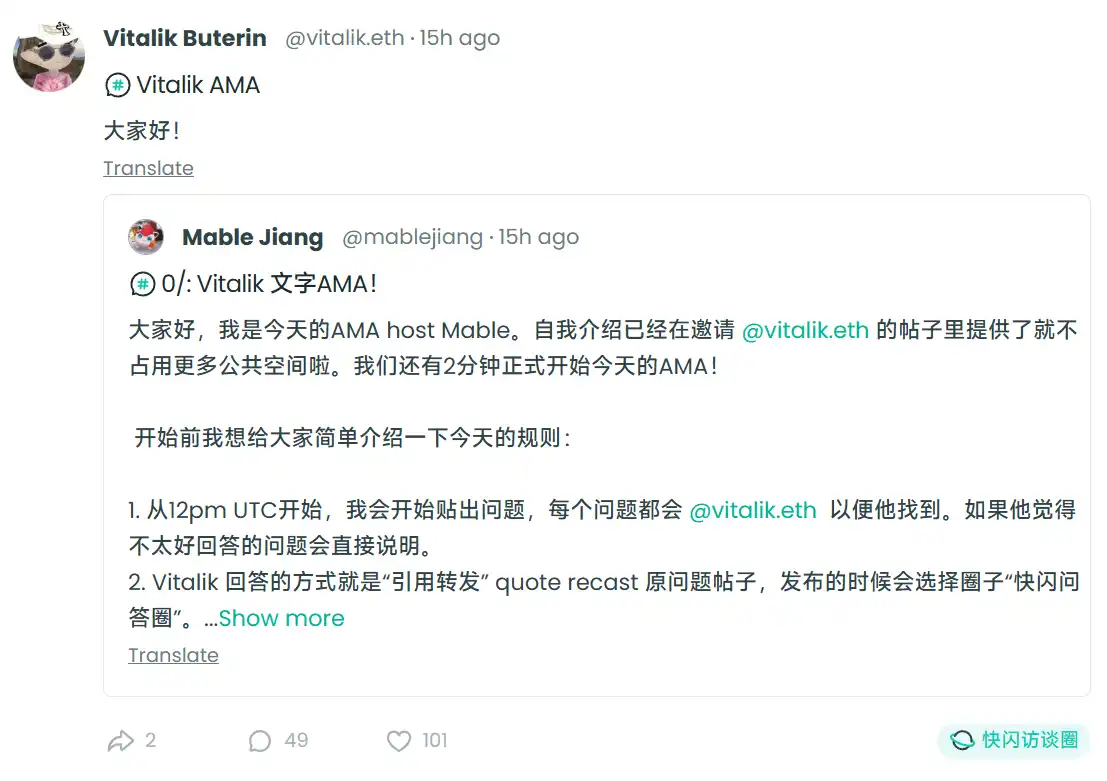
The following is a compilation of the contents of this AMA:
Q1: In your mind, should today’s Ethereum be closer to the existence of Bitcoin or the existence of the world’s computer? You mentioned in your previous X post that many of those who hold negative views on ETH are actually short-term speculators, and their frustration will hardly help the ETH community in any constructive way. However, many people in the OG ETH-Maxi camp have also promoted the concept of “ETH is money” in a high-profile manner (such as Bankless, the largest ETH Maxi media) and compared ETH with BTC, believing that it is another competitive form of digital currency (and possibly even a better form of currency). What is the ultimate narrative you envision for the future adoption of ETH?
Vitalik:
Is Ethereum the world’s computer or currency? I think these two ways of thinking are compatible.
If you need to distinguish which blockchains are “truly decentralized,” you can use a relatively simple test: If his foundation disappears, will the chain survive? I have a feeling that only Bitcoin and Ethereum can answer clearly: of course. Most of Ethereum’s development is outside the foundation, and the client team has independent business models. Nowadays, many researchers are not in the foundation, and almost all activities except Devcon are independent. Reaching this stage is difficult, something Ethereum didn’t have to do five years ago.
Giving up these advantages in order to pursue TPS is a big mistake, because there is always a new chain coming out, and suddenly there is a higher TPS than you. But decentralization and resilience are valuable, and few blockchains have them.
These characteristics are conducive to making a digital currency with long-term value and also conducive to having a good world computer. But the world’s computers also need to solve the problem of capacity expansion. “World computer” does not mean “a computer that can simultaneously support every application of the world”, but “a place where the world’s applications can operate with each other.” High-performance computing can be placed in L2, no problem. However, this stunning beauty still requires L1 to have enough scale. The specific details can be seen in an article I recently wrote: “Vitalik Newsletter: Substantial expansion of L1 is still valuable and will make application development simpler and safer”
ETH is a digital asset suitable for use among the world’s applications (including finance, but also other applications, such as ENS, etc.). ETH also doesn’t need every transaction to be placed in L1, but it needs to have enough throughput so that anyone who wants to use L1 can use L1 at least occasionally. So these two directions are also compatible here: the features that help Ethereum become a better world computer are also the features that make ETH a better digital currency.
Q2: Today, many L2s have appeared, mainly from the OP stack system, and there are also some attempts at zkrollup. I would like to hear your evaluation of the rollups route over the past few years. I hope it will be as objective as possible: what do you think is better and what is different from what you expected back then; are rollups generally good for Ethereum or blood-sucking (I saw you calling on these L2s to give back to Ethereum a few days ago)? Does ETH really need these L2s?
Vitalik:
Ethereum requires hybrid L1 + L2. So far, our expansion method can be roughly understood as hybrid L1 + L2, but I don’t think anyone has clearly defined which transactions should be in L1 and which transactions should be in L2.
The answer “everything is in L2” is more difficult to accept because:
* This way, it is easy to lose the position of ETH as medium of exchange, store of value, etc. If you are worried that L2 will steal L1 users and not give L1 anything back, this problem will be even more serious in a situation where “L1 does almost nothing”
* Cross-L2 operations still require L1. If something goes wrong with one L2, users still need to have a way to move to another L2. So there are some L1 use cases that are difficult to avoid. I wrote an article on this topic here: “Vitalik Newsletter: Substantial expansion of L1 is still valuable and will make application development simpler and safer”
The answer “everything is in L1” is also more difficult to accept because:
* If L1 supports many transactions, it will be easy to become centralized, even using technologies such as ZK-EVM
* The world’s demand for transactions on the chain is unlimited. No matter how high the TPS of L1 is, you can always find an application that requires 10 times more TPS (e.g., artificial intelligence, micropayments, micromarket prediction, etc.)
* L2 not only does capacity expansion, L2 can also provide faster confirmation speed through preconfirmations and avoid MEV problems through sequencers
So we need hybrid L1 + L2. I think the role of L2 will continue to change. For example, it seems that evm-equivalent L2 is enough now. Maybe we will see more privacy-focused L2s (aztec, intmax, etc.), maybe there will be more application-specific L2s.(If an application wants to control its own MEV situation, there are benefits here, etc.) So in the short term, I think we should continue to improve L1 ‘s capabilities at the same time, add blobs to give L2 more space, promote cross-L2 interoperability, and then the market will decide which expansion method is suitable for which application.
Q3: The rollup route has been proposed for quite a long time. Do you think that the current centralized sequencer of Arbitrum / Base / OP is a big challenge for future supervision because it cannot be truly censory-resistant? Do you think they will move towards the decentralized sequencer approach? If your answer to the previous question is yes, what do you think of MegaETH’s centralized sequencer solution?
Vitalik:
Regarding centralized sequencers, centralized sequencers actually have many advantages:
* Centralized sequencer can ensure that it will not steal users ‘money through methods such as frontrunning
* instant preconfirmations
* It’s easy to turn a traditional application into a blockchain application because the server directly becomes a sequencer
The decentralized features of blockchain can be used to avoid the risks of centralized sequencers: the forced inclusion mechanism prevents the sequencer censor user, and the optimistic or zk proof mechanism prevents the sequencer from changing or violating the application’s rules (for example, suddenly inflate a token or nft collection)
However, centralized sequencers still have risks, so we cannot completely rely on centralized sequencers to solve problems. It is also important to have the ability to have based rollup or directly trade on L1. So I support an ecosystem that promotes both methods at the same time, and then we can see which method is more suitable for which application. Maintaining the ability of ordinary users to make censorship-resistant transactions is of course critical.
Vitalik replied,”In fact, my starting point is that U.S. regulators may go after them. Of course, the probability may not be very high”:Possible solutions and attempts at single sequencers to resist censorship. If this happens, there are two possibilities:
1. DAO will choose sequencer and backup sequencer, and will always move to new sequencer
2. We use basic rolls
I think the first one is worth studying. I know that some L2 teams are thinking about this direction in the past. The second one is a backup. There may also be other reasons why we think based rolls are better and start using more based rolls directly. The advantage of Ethereum is that we can try several directions at the same time.
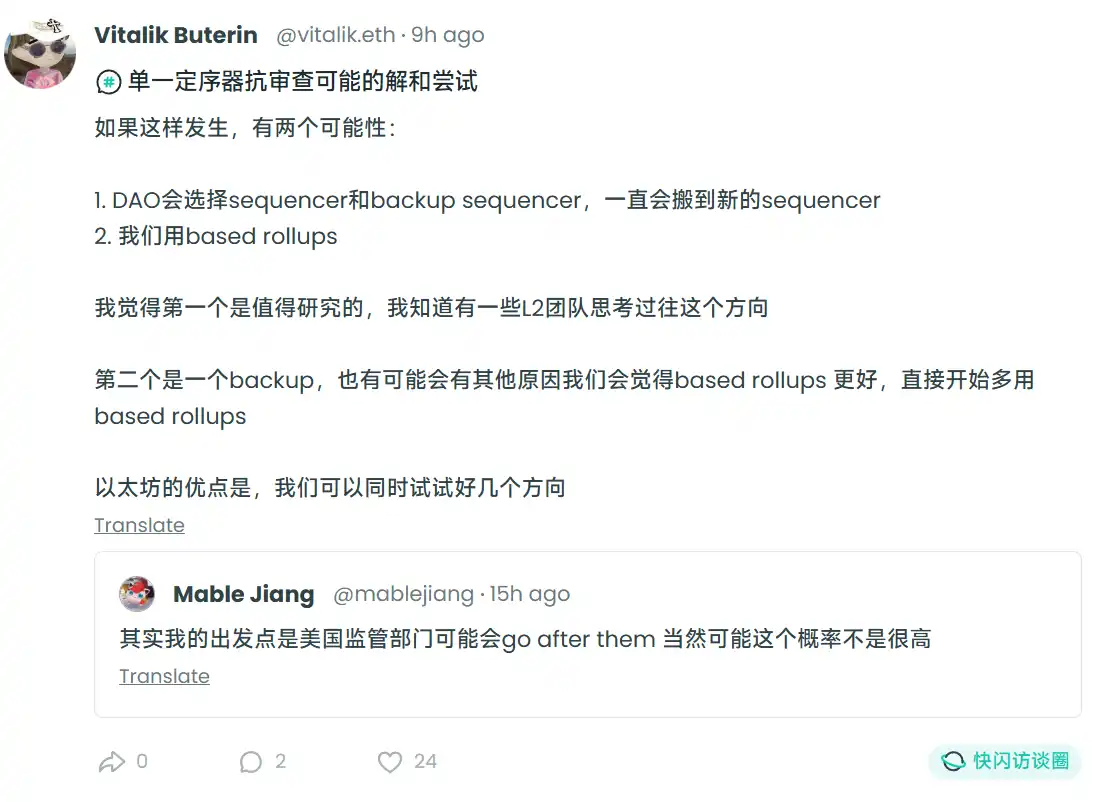
Q4: The technical route of ETH 3.0, what are the differences between the goals you hope to achieve and the goals you hope to achieve in the rollup era? When Devcon announced the 3.0 design plan in November last year, did it take into account that rollover does not really provide practical value to the Ethereum main network at this stage?
Vitalik:
Value capture relationship between L2 and L1. There is nothing called ETH 3.0 right now. Some people will say that Justin Drake’s five-year plan is, but that plan is only a consensus layer, not an execution layer, so it is only part of the future of the Ethereum blockchain.
The relationship and balance between L1 and L2 is an execution layer issue. Here’s another roadmap: strengthening L1 capabilities (increasing gaslimit, adding stateless verification (such as verkle) and other features, etc.), improving interoperability across L2, improving blobs, etc. I also think the question of whether L2 pays enough transaction fees to L1 cannot be viewed from a short-term perspective. For example:
* Before 4844, everyone’s complaint was the opposite: Did L1 suck blood from L2?
* Now, the blob fee for the last 30 days is 500 ETH
* If the blob target is increased from 3 to 128, according to our plan, if the blob gasprice is the same, it will burn 21333 ETH per month and 256,000 per year.
So the narrative here is easy to change quickly, and now we need to strengthen L1 so that what should happen in L1 can happen in L1, increase blobs, and then maintain adaptability in our community.
Q5: You decided to step up and lead EF again. I believe it took a lot of consideration. This was a very difficult decision. It was a kind of courage to leap into the abyss with indulgence. I admire it very much. Would you mind sharing your entire thinking process with us today? At the same time, I am very curious whether you recognize socialism with China characteristics? The starting point of my question is the “proper board” mentioned in your discussion with Ameen: Do you think organizations need strong leaders to guide and correct directions before embarking on the right development path?
Vitalik:
“Decentralization” does not mean “doing nothing”.
I think the blockchain community, and the entire world, are in a relatively dangerous state now. There are many things happening that have no long-term value or even malicious value. These things and the people behind them get a lot of attention. But we can’t just shout against these things and not mention better alternatives. So our goal should be to do this alternative well and demonstrate that a stable, brighter future is possible.
Here I also talk about the blockchain circle (if memecoin, which drops 97% in one day, is not our future, then what is?) And a macro social aspect: Many people now feel that a democratic approach is impossible and can only rely on the leadership of a strong man to do things. But a political scientist at devcon told me that one of the reasons why he respected Ethereum very much is that we are a truly open and decentralized ecosystem. We have been successful at this scale, which gives him hope. So if we can succeed in this way, the positive impact on the world could be huge, giving many people bright examples of success that they can follow.
But “decentralization” does not mean “doing nothing.” The Ethereum Foundation’s philosophy of subtraction does not mean “reducing the foundation to 0”, but a way to maintain ecological balance. If there is an ecological imbalance in one place (for example, a part of the ecology is too centralized, or there is an important public good that no one else does), we can help counterbalance. After solving this problem, the foundation can withdraw from that area. If there is an imbalance in a new place, we can move resources there, etc.
In China culture, the way we pursue may be most similar to the thoughts of Tao Te Ching, but walking this path requires intelligence and the ability of the foundation to be improved in some places. It is not a question of “success without doing anything.” So in the short term, we need to put more effort into doing some important pivots.
Q6: I don’t belong to the core Ethereum circle, so I’m not too clear about some detailed political issues. From your own perspective, what are the main reasons why some ETH Maxis OG left the Ethereum community? When shuyao and I were recording a podcast, she mentioned an interesting point: Ethereum needs to be zeroed before it can be rebuilt (half in joke). At this stage, do you think Ethereum is indeed facing a major reshuffle of existing holders and community members in order to find its own path?
Vitalik:
Ethereum needs new stories and new users.
There are many different people with different stories. For example, there are many people in the blockchain circle who would say 10 years ago that the goal of blockchain is to be a globally neutral system that protects individual freedoms and counterbalance the hegemony of the government. Now, if a president issues memecoin, they will say, Wow, this is a real world adoption, so good, but why does it happen on other chains? If we can be more friendly to those politicians, it will happen on our chain next time! I personally feel that this kind of person has gone astray. Of course they will say, I am too purely idealistic, unrealistic, etc. Each party has its own story.
There are also some people who will say that Ethereum’s ecology is too OG controlled and there is not enough space for new people to come in. But this criticism is in another direction, and there are different groups issuing these arguments.
I think there is only one suitable way out of these dilemmas: We need to have some updated stories explaining why Ethereum is, what ETH does, what L1 and L2 do, etc. This is not the era of infra, it is the era of applications, so these stories cannot be abstract free, open, censory-resistant, sunpunk public goods, etc.”, which requires some clear application layer answers. I plan to support more in the near future: info finance (which is also the direction of AI + crypto), privacy protection, high-quality public goods financing methods, and continuing to do a good job in the world’s open financial platform. Of course, this must include real world assets. There are many things here that are valuable to many users at the same time and are in line with the values we have always had. We need to re-support this direction, and it can also give new people more opportunities to come in.
Q7: Do you think Ethereum needs more commercial company-type management? Do you think that the current difference between ETH and SOL is essentially a difference in efficiency between different “organizational forms” and a difference in achieving different goals? What are the goals to achieve?
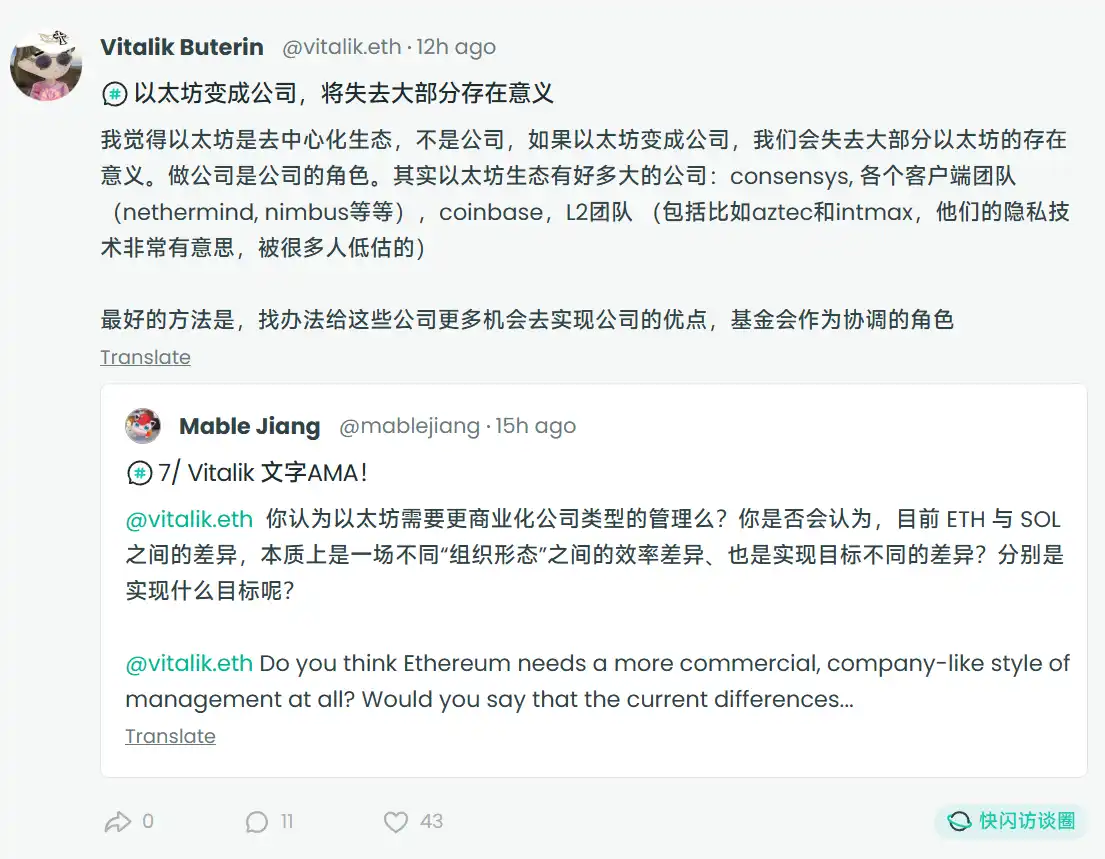
Vitalik:
Ethereum becomes a company and will lose most of its meaning.
I think Ethereum is a decentralized ecosystem, not a company. If Ethereum becomes a company, we will lose most of the meaning of Ethereum. Being a company is the role of the company. In fact, there are many large companies in the Ethereum ecosystem: consensys, various client teams (nethermind, nimbus, etc.), coinbase, and L2 teams (including e.g. aztec and intmax, whose privacy technologies are very interesting and underestimated by many people).
The best way is to find ways to give these companies more opportunities to realize their strengths, with the foundation acting as a coordinating role.
Q8: You have always paid close attention to the application of ZK technology in the web3 field. In addition to ZK applications in asset trading scenarios, in social media networks, what scenarios do you think can introduce ZK to achieve privacy protection?
Vitalik:
I am very interested in many non financial zk use cases, such as:
* anti-sybil verification. Many services require you to sign in with kyc not because they like to know who you are, they just want to know that you are not a robot, or that if you are banned, you cannot reopen your account 100000 times. Implementing this use case only requires zk proof of personality, or proof of reputation. In fact, sometimes proof of tokens is enough, such as anonworld
* Use cryptography to make AI applications that protect privacy. Zk may not be the most suitable technology here. FHE may be. Recently, FHE has made a lot of progress. If we can reduce the overhead of FHE, there may be a chance.
* Wrap any web2 account with zk-snark and use it on web3. Zkemail, anon aadhaar, zkpassport, zktls, etc. are good examples.
I think this technology has many opportunities to solve many security, governance and other issues in social and other areas by protecting personal freedom and privacy.
Q9: If you encourage more developers to join Ethereum, encourage and retain existing developers (compared to some new L1 or even L2 developer incentives, Ethereum must have a more complex situation), will it be the current priority? Accelerate network decentralization, improve scalability, and explore more application scenarios Apps. Among these three aspects, which one do you think is currently the highest priority for Ethereum?
Vitalik:
The alignment of the Ethereum community is not a social game but a technical game. Here we actually need to find a way to solve three problems at the same time:
1. attract more developers
2. Developers are encouraged to develop applications that are more open source, secure, comply with public standards, have long-term value, and so on
3. In the process of solving (2), avoid the situation where the ecology becomes a closed circle (the phenomenon of “we are aligned because we are good friends of developers”)
So I recently said that ethereum alignment should be a technical game, not a social game. I want to emphasize this issue because I think that in terms of decentralization nowadays, the most urgent decentralization issue is often not the L1 issue, but the L2 or wallet or application issue. So the entire ecosystem needs to work together to simultaneously expand and attract new developers and advance in these decentralized and trustless aspects.
There are several ways we can help achieve this:
1. Education makes it easier for developers to understand why blockchain is, what should be on the chain and what should not be on the chain, what needs to be cared about in the field of blockchain, etc.
2. If parts of some blockchain-specific technologies are too difficult for application developers, the foundation can do it themselves, making it easier for developers to combine. For example, zk’s programming language, a16z’s helios, and so on
3. Give developers clear standards. For example, if you make an Ethereum client and there are many tests, you can run the tests yourself and see if your client can pass. If you do L2, there are frameworks for L2beat stage1, stage2, etc. This should also be given to zk apps, wallets, etc.
Q10: Today, when AI accelerates the evolution and development of technology, you have mentioned the concept of d/acc (de-accelerationism/or defensiveness against accelerationism). Now it seems that the effective acceleration process of decentralization/decentralization of scientific and technological rights is in line with your expectations? Are you worried about any hidden dangers in this regard? I actually feel a little powerless, that is, I know that “Beijing Fold” may be a future. From a humanistic perspective, I don’t want it to happen, but I feel that it is getting closer and closer to us.
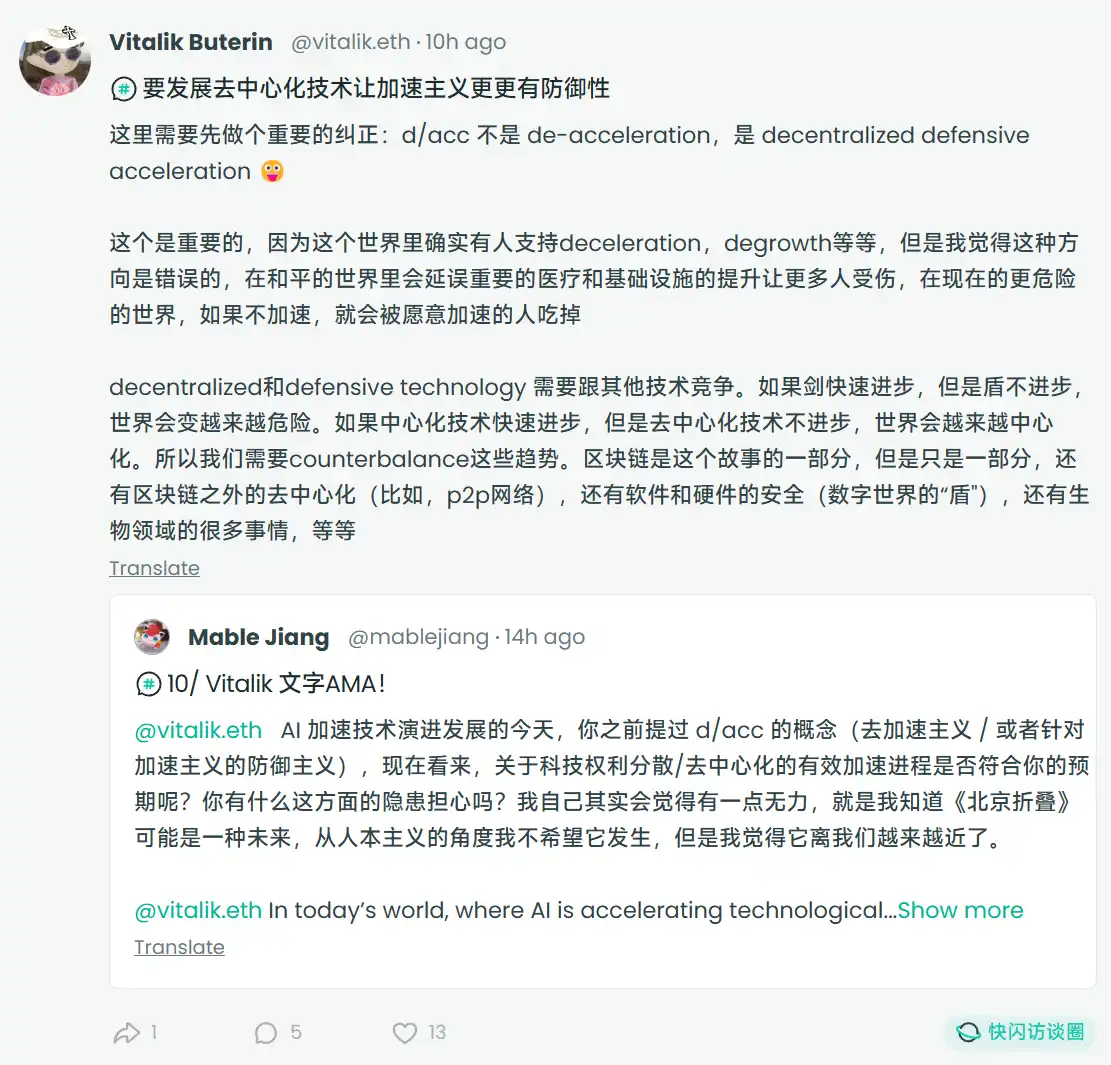
Vitalik:
An important correction needs to be made here first: d/acc is not a de-acceleration, but a decentralized defensive acceleration. This is important because there are indeed people in this world who support decentralization, degrowth, etc., but I think this direction is the wrong one. In a peaceful world, important medical and infrastructure improvements will be delayed and more people will be injured. In today’s more dangerous world, if we don’t accelerate, we will be eaten by those who are willing to accelerate.
Decentralized and defensive technology need to compete with other technologies. If the sword improves rapidly but the shield does not, the world will become more and more dangerous. If centralized technology advances rapidly, but decentralized technology does not advance, the world will become more and more centralized. So we need to counterbalance these trends. Blockchain is part of the story, but only part, as well as decentralization beyond blockchain (e.g., p2p networks), software and hardware security (the “shield” of the digital world), and a lot of things in the biological field, and so on.
Q11: Do all employees of the Ethereum Foundation, including leadership teams, have an assessment mechanism such as KPI/OKR? Non-profit organizations generally have problems with inefficiency. Do you think EF has such problems? If so, how to solve it? Can you explain in detail how to accelerate the development of Ethereum in various aspects? Eth has been ten years old and is updated once a year. I feel that the development progress is a bit slow and needs to be greatly accelerated.
Vitalik:
Q12: How do you understand the role of Crypto as an anti-establishment infrastructure in realizing Degencomiism? Do you think the current Memecoin (and I mean more quickly launched on Solana) is a “beneficial chaos” for realizing Degencomiism? (This word comes from your blog) If you can’t find the anonymity feature, just post it directly. At the same time, I strongly recommend you to play “Disco Elysium”. I believe you will like it.
Vitalik:
The core of Degencomi is to make better “rules of the game.” Chaos is not necessarily beneficial or bad, it depends on the situation. The interesting question is, how can we make “rules of the game” so that the chaos of natural production in the community has good results?
For example, national civil wars have bad effects unless they are to get rid of malicious tyranny. But market chaos often has good results, eliminating old inefficient companies and giving new companies opportunities to come in, but sometimes markets can also cause the problems we see in blockchain circles. So this is actually very complicated.
So how can we make better rules? I think memecoin is far away from ideals now. I wrote this article last year to see if there was a better direction “Vitalik talks about meme again: What room for imagination does meme have?”
Q13: You should know about Simon de la Rouviere’s “This Art is Always on Sale” Harberg tax experiment (patronage as an asset class). Do you think this kind of experiment can make new progress in future decentralized Social networks? Are there any mechanisms you would like to see being used to experiment with decentralized social networking?
Vitalik:
Yes, I think decentralized social media is a good opportunity to try out a lot of new mechanisms. Harberger tax is an example, and there are also some examples:
* A mechanism similar to community notes https://vitalik.eth.limo/general/2023/08/16/communitynotes.html
* creator payouts, similar to twitter and youtube but more fair and transparent. Try retro funding, deep funding, quadratical funding, etc.
* Integrating social media and DAO governance
Q14: What do you think of us as a group of people in the encrypted world, but still rely heavily on centralized social applications such as Telegram and Twitter for communication and collaboration? Building decentralized social media and true encrypted communication tools does not seem to have attracted so much attention and recognition. Does their development so far still meet your expectations? What advice do you have for teams exploring and building in this field?
Vitalik:
This is also an issue that I am very concerned about. I personally have been trying to move most of my conversations from telegram to signal in the past 2 years. But the signal is also imperfect. Although it is confidential, it is still centralized and has no interoperability. You need to have a mobile phone number to log in, the server sees a lot of your metadata, and so on.
But it is difficult to make a higher-quality messenger. I try status every year, and they try to be completely decentralized. They do a good job, but they still have some reliability issues. In fact, there are various small teams to be their own messengers now, but they are not united, so it’s easy that each one is not good enough.
I recently started using fileverse to do various of my documents, and I found that the user experience of this is good enough, and now it is used by many people in the foundation. If there is a decentralized, encrypted, etc. messenger that can achieve this quality, I will definitely work hard to help the community move to this messenger.
Q15: I have heard from people in the Milady community that you may have chosen Milady for some reason, but I am still curious how you will explain your sense of identity with Milady?
Vitalik:
I think milady attracts many people because this Internet community does two things at the same time:
1. Not boring
2. not malicious
If you look at the current mainstream world circles, you will find that it is very difficult to achieve these two conditions at the same time. Milady is one of the most successful examples.
Q16: Are you a Communist?
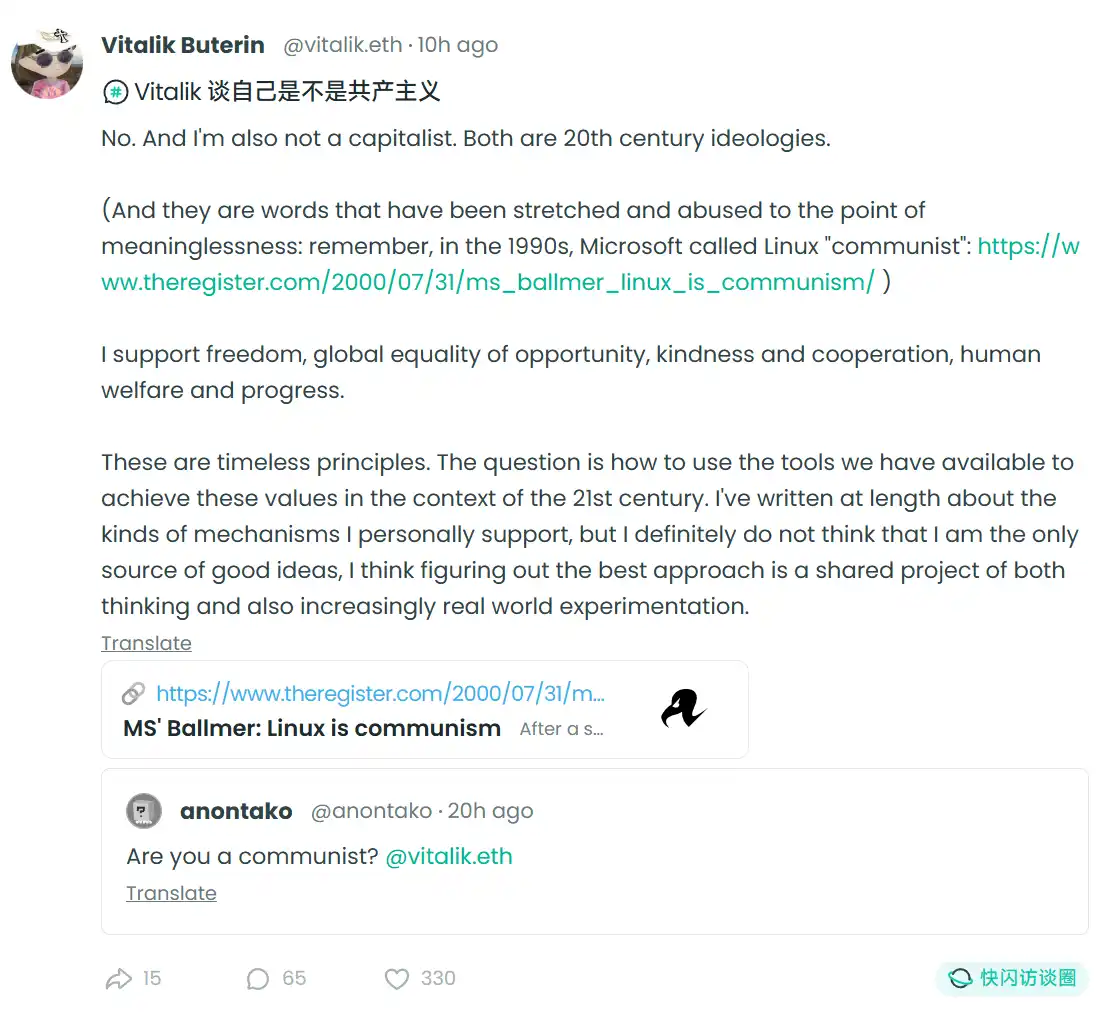
Vitalik:
No, I’m not a capitalist either. Both are 20th century ideologies.
(These words have been stretched and abused to the point of being meaningless: remember, in the 1990s, Microsoft called Linux “communism”: https://www.theregister.com/2000/07/31/ms_ballmer_linux_is_communism/)
I support freedom, global equality of opportunity, kindness and cooperation, human well-being and progress. These are timeless principles. The question is how to use the tools we have available to realize these values in the context of the 21st century. I have written in detail about the various mechanisms I personally support, but I definitely don’t think I’m the only source of good ideas. I think finding the best way is a common project that requires both thinking and increasingly realistic world experimentation.
Q17: Can you explain in detail how to accelerate the development of Ethereum in various aspects? Eth has been ten years old and is updated once a year. I feel that the development progress is very slow and needs to be greatly accelerated. eth/acc
Vitalik:
Ethereum development is currently focusing on increasing the number of blobs. The main goal now is to increase the number of blobs. Here are:
* pectra, increase the blob target from 3 to 6
* Fusaka, add peerdas, and increase the blob target
* Continue to optimize peerdas in 2026 and 2027
* Add 2D data availability sampling and increase the blob target
There are also roadmap to increase L1 gas limit, but this is more complex, such as delayed execution, statelessness, etc.
Q18: Today’s vitalik has grown gold claws and silver scales, transforming from a dragon slaying boy into a dragon. During the Ethereum mining era, there was still a democratic consensus, but now V’s management system is an authoritarian management model. After moving to pos, it changed from a democratic system to a People’s Congress system, suspected of secretly joining the party behind everyone’s back?
Vitalik:
POS is not a governance method in Ethereum. PoW can only be democratic in the short term. Because there are always economies of scale, larger miners are more efficient, so they become more and more centralized over time.
I think we probably didn’t have ASICs before PoS because everyone knew that we planned to move to PoS, so no one built ASICs. If we declare from the first day that we will always PoW, it is likely that ASICs will come out between 2016 and 19, unless we have been making fork changes every year, but this is also centralized.
So I think our method, spending 7 years using PoW for distribution and then moving to PoS, is the best. PoS has its own fairness: if you have 10 times more money, you can produce 10 times more blocks. In ASIC PoW, there are economies of scale, possibly 10 times more money = 11 times more blocks. Another point: PoS is not a governance method in Ethereum. Ethereum holders have no right to choose which EIPs to place on the next fork, etc. If we used PoS to make such decisions, it would be too plutocratic.
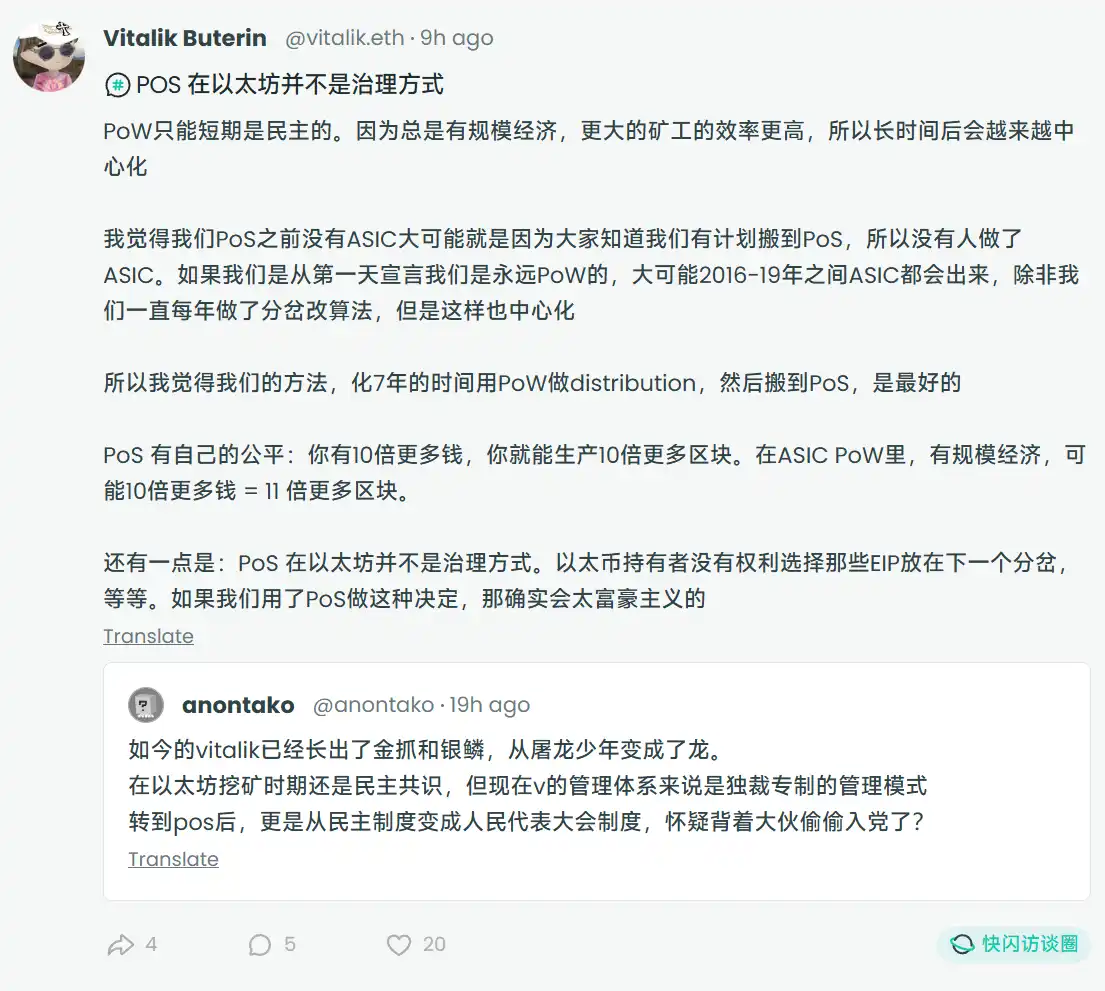
Welcome to join the official social community of Shenchao TechFlow
Telegram subscription group: www.gushiio.com/TechFlowDaily
Official Twitter account: www.gushiio.com/TechFlowPost
Twitter英文账号:https://www.gushiio.com/DeFlow_Intern



